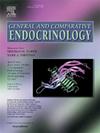神经分泌蛋白GL刺激日本鹌鹑摄食行为和脂肪积累
IF 1.7
3区 医学
Q3 ENDOCRINOLOGY & METABOLISM
引用次数: 0
摘要
神经分泌蛋白GL (NPGL)是一种新的下丘脑神经肽,可促进大鼠、小鼠和新生雏鸡的脂肪积累。然而,它在日本鹌鹑(Coturnix japonica)中的作用尚不清楚。在这项研究中,我们研究了慢性脑室内灌注NPGL对5周龄雄性日本鹌鹑体重、食物摄入和脂肪沉积的影响。13天的NPGL输注显著增加了体重、食物摄入量以及皮下脂肪、腹部脂肪和肝脏的体积。相比之下,水的摄入量和胰腺、睾丸、心脏和肌肉的质量保持不变。血液中甘油三酯、葡萄糖和非酯化脂肪酸的浓度未受影响。Real-time qPCR分析显示,NPGM是NPGL的一个副同源基因,在下丘脑中显著上调。此外,肝脏中参与脂肪生成的关键酶硬脂酰辅酶a去饱和酶1 (SCD1)的表达呈上升趋势。虽然用作SCD1活性指数的脂肪酸比率(棕榈油酸酯/棕榈酸酯)没有变化,但肝脏和腹部脂肪的新生脂肪生成指数(棕榈酸酯/亚油酸酯)都有增加的趋势。这些结果表明,NPGL促进日本鹌鹑的脂肪积累,表明其可能参与鸟类肥胖。本文章由计算机程序翻译,如有差异,请以英文原文为准。
Neurosecretory protein GL stimulates feeding behavior and fat accumulation in Japanese quails (Coturnix japonica)
Neurosecretory protein GL (NPGL) is a novel hypothalamic neuropeptide that promotes fat accumulation in rats, mice, and neonatal chicks. However, its role in Japanese quail (Coturnix japonica) remains unclear. In this study, we investigated the effects of chronic intracerebroventricular infusion of NPGL on body mass, food intake, and fat deposition in five-week-old male Japanese quails. A 13-day infusion of NPGL significantly increased body mass, food intake, and the masses of subcutaneous fat, abdominal fat, and liver. In contrast, water intake and the masses of the pancreas, testes, heart, and muscle remained unchanged. Blood concentrations of triglyceride, glucose, and non-esterified fatty acid were unaffected. Real-time qPCR analysis revealed a significant upregulation of NPGM, a paralogous gene of NPGL, in the hypothalamus. Additionally, the expression of stearoyl-CoA desaturase 1 (SCD1), a key enzyme involved in lipogenesis, showed an increasing trend in the liver. Although the fatty acid ratio used as the SCD1 activity index (palmitoleate/palmitate) did not change, the de novo lipogenesis index (palmitate/linoleate) tended to increase in both the liver and abdominal fat. These results suggest that NPGL promotes fat accumulation in Japanese quails, indicating its potential involvement in avian adiposity.
求助全文
通过发布文献求助,成功后即可免费获取论文全文。
去求助
来源期刊

General and comparative endocrinology
医学-内分泌学与代谢
CiteScore
5.60
自引率
7.40%
发文量
120
审稿时长
2 months
期刊介绍:
General and Comparative Endocrinology publishes articles concerned with the many complexities of vertebrate and invertebrate endocrine systems at the sub-molecular, molecular, cellular and organismal levels of analysis.
 求助内容:
求助内容: 应助结果提醒方式:
应助结果提醒方式:


